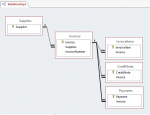Hi,
I'm currently working on a short project to create a database for accounts payable. The main use of this database will be collecting all details from invoices and credits from a particular supplier and print reports of invoices due etc.
It shouldn't take me too long but I wouldn't mind some advise before I jump head first :banghead:
When an order Is invoiced sometimes a partial credit is needed against it which then changes the amount due on this invoice. I would like to some how link both invoices and credits together so when a credit is issued against an invoice I can quickly enter the invoice number, add the credit to it (while also inputting the credit note information).
My thought was using the ID field as my invoice number - would this correct or should I use the autonumber function anyway?
As far as I have got:
Tables needed
Invoices
Credits
Payments.
Thanks in advance
I'm currently working on a short project to create a database for accounts payable. The main use of this database will be collecting all details from invoices and credits from a particular supplier and print reports of invoices due etc.
It shouldn't take me too long but I wouldn't mind some advise before I jump head first :banghead:
When an order Is invoiced sometimes a partial credit is needed against it which then changes the amount due on this invoice. I would like to some how link both invoices and credits together so when a credit is issued against an invoice I can quickly enter the invoice number, add the credit to it (while also inputting the credit note information).
My thought was using the ID field as my invoice number - would this correct or should I use the autonumber function anyway?
As far as I have got:
Tables needed
Invoices
Credits
Payments.
Thanks in advance


